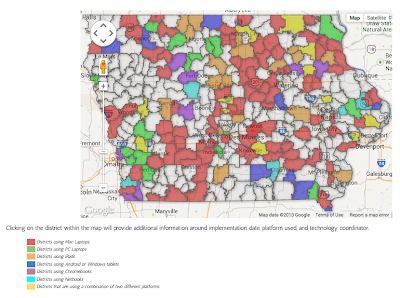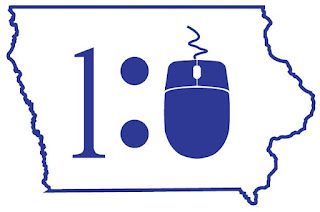 |
| Dr. Jerry Schnabel |
In my last post, we looked at factors that did not influence
superintendents to implement a 1:1 initiative in their district. These included
“keeping up with the Jones,” attracting students from
neighboring districts, increased student achievement and budget. So . .
. onto factors that did influence their decision:
School Visitations:
When I had finished the interviews with the superintendents, my first
observation was that the decision to implement a 1:1 initiative was not made in
isolation. Without exception, a factor
that influenced the superintendent’s decision was visits to others schools that
had implemented a 1:1 initiative. All the superintendents I interviewed told me that they had sent
teams to schools that had already implemented a 1:1 initiative to see for
themselves, firsthand, a program that was already in place. These teams consisted of teachers,
administrators and in some cases school board members and students. The number of visits each team made to other
schools ranged from 3-20.
Political
Considerations: The superintendents also talked about the multiple efforts
they undertook to work with staff, school board, parents and the broader
community to engage and keep them informed of the progress of the
consideration. Most superintendents
assumed the students would be receptive to the idea, but in one instance,
students got the notion that once the computers arrived, all the teachers would
be fired and students would receive their education strictly via the
computer. So, a lesson learned was not
to overlook the students and to enlist them in the exploration process.
Equity: Equity was another factor that influenced the
superintendents in the study in their decision to implement a 1:1 initiative. The superintendents talked about equity in
terms of equal access to learning opportunities for all students. These
opportunities included access to technology and online resources.
Staff Readiness: The superintendents in the study indicated staff
readiness was an additional factor that influenced their decision. Staff
readiness fell into two categories. The first was characterized by the staff
being open to or supporting the idea of implementing a 1:1 initiative. The
other category of staff readiness was their comfort using the technology. There was a consensus among the
superintendents that staff would need to gain further technology skills, but
none of the superintendents were held back because of the technology skill
level of the staff. Districts were also
on a continuum of teacher possessing the pedagogical skills required to teach
in a one-to-one classroom. But all superintendents
felt their staff could gain this understanding through training and experience
in the one-to-one classroom.
Student Engagement: This was an important factor in the decision. One superintendent remarked that “when we
observed and went to other schools and we saw student involvement in the
classroom, that became our number one thought.
What a wonderful thing—you have 27 kids in class, everybody is involved,
everybody is interested.” Even once
implemented, when the students told the administration in one district that
they were not using the computers enough, the district’s response was to send
the students to another district that was using the technology successfully.
Students wanted to be engaged and after the visit to another district, they
returned to their district and helped design changes in the classroom that
increased student engagement.
Best for Students: The most important factor that influenced
superintendents to implement a 1:1 initiative was they felt it was what was
best for students. This was an
unexpected finding and the conclusion was based on examination of the
transcripts in response to the question: “As you reflect on the various factors
that influenced your decision to become a one-to-one school, what was the most
important?” One Superintendent articulated
acting in the best interest of children in terms of increased opportunities for
students being the most important factor in her decision. “To be able to create things for their
classes and projects. To have an endless
amount of resources to do that. I see
some of the projects that our kids are doing and I feel that it has been a
smashing success with seeing the kids create stuff even more amazing than we
thought they would when you give them these tools.”
This was also cross-referenced
using Wordle, an online tool found at http://www.wordle.net/.
When the transcripts of the
interviewee’s answers were displayed in Wordle, “important” and “kids” are used
most often and thus, appear as the largest words. The words that were used most frequently
after that included “students,” “involvement,” “education,” “everybody” and
“projects.” In contrast, when asked, “as
you reflect on the various factors that influenced your decision to become a
one-to-one school, what was the least important?” the word “kids” does not
appear.
Figure 1: Wordle Display for the Most Important Influence on the
1:1 Decision
As the map of 1:1
districts in Iowa continues to add more schools, there is a likelihood that
many of the factors discussed in this piece influenced the decisions to
implement the 1:1 initiative. And it’s
good to know that these decisions are not being made to “keep up with the
Jones” but rather to do what is best for students.
Jerry Schnabel is the
Director of Information and Technology Services at AEA 267
in Cedar Falls, Iowa. He may be reached via email at: jschnabel@aea267.k12.ia.us







